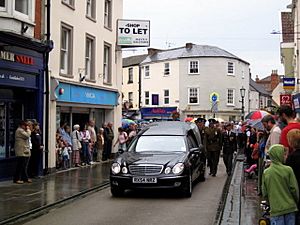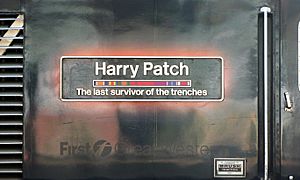Harry Patch facts for kids
Quick facts for kids
Harry Patch
|
|
|---|---|

Patch, aged 109, in 2007
|
|
| Birth name | Henry John Patch |
| Born | 17 June 1898 Combe Down, Somerset, England |
| Died | 25 July 2009 (aged 111 years, 38 days) Wells, Somerset, England |
| Buried | |
| Allegiance | |
| Service/ |
|
| Years of service | 1916–1918 |
| Rank | Private (after demotion) |
| Service number | 29295 |
| Unit | Duke of Cornwall's Light Infantry |
| Battles/wars | |
| Awards | See medals |
| Spouse(s) |
|
| Children | 2 |
Henry John Patch (born June 17, 1898 – died July 25, 2009) was an amazing English man. He was known as "the Last Fighting Tommy" because he was the last soldier from the First World War who fought in the trenches.
Harry was also a supercentenarian, which means he lived to be over 100 years old. He was briefly the oldest man in Europe. When he passed away at 111 years old, he was the third-oldest man in the world.
Contents
Harry Patch: A Life of Service
Early Life and Family
Harry Patch was born in a village called Combe Down, near Bath, Somerset, England. His father was a stonemason. Harry grew up with his two older brothers.
His family lived a long time. His father lived to 82, and his mother lived to 94. Harry left school in 1913 and started learning to be a plumber in Bath.
World War I Experience
In October 1916, during the First World War, Harry was called to join the British Army. He became a private soldier. He was briefly promoted to lance corporal but was later demoted.
Harry joined the 7th Battalion, Duke of Cornwall's Light Infantry. He worked as an assistant gunner with a Lewis gun. In June 1917, he arrived in France.
He fought on the Western Front in a very famous battle called the Battle of Passchendaele. On September 22, 1917, a shell exploded near him. Harry was wounded, and three of his friends were killed.
He was sent back to England in December 1917 to recover. Harry always remembered September 22 as his own special Remembrance Day. He was still getting better when the war ended in November 1918.
Medals and Honors
Harry Patch received many awards for his service. For his bravery in the First World War, he got the British War Medal and the Victory Medal.
In 1998, France made him a Knight of the Légion d'honneur. This was a very special award, given to him on his 101st birthday. Later, in 2009, he was made an Officer of the Légion d'honneur.
In 2008, the King of Belgium gave Harry the award of Knight of the Order of Leopold. He received this on September 22, 2008. This was exactly 91 years after he was wounded and his friends died.
Harry also received the 1939–45 Defence Medal for his service in the Second World War. His medals are now shown at the Duke of Cornwall's Light Infantry Museum in Bodmin.
Life After the War
After the First World War, Harry went back to being a plumber. He worked on the Wills Memorial Building in Bristol for four years. During the Second World War, he became a part-time fireman in Bath.
He later moved to Street, Somerset, and ran his own plumbing company. He retired when he was 65 years old. Harry was married twice, first to Ada Billington and later to Kathleen Joy. He had two sons, Denis and Gordon.
Honorary Degree
In 2005, Harry received an honorary Master of Arts degree from the University of Bristol. This was special because he had helped build some of the university's buildings in the 1920s.
He was recognized by Guinness World Records as the oldest person to ever receive an honorary degree. He was 107 years old at the time.
A Voice for Peace
Harry Patch didn't talk much about his war experiences for a long time. But in 1998, he decided to share his story. He realized he was one of the last people who remembered "the war to end all wars."
He appeared in TV shows like World War 1 in Colour. He spoke about his lost friends and a moment when he faced a German soldier. Harry said he couldn't bring himself to kill the soldier. Instead, he shot him in the shoulder and ankle.
In 2004, Harry met Charles Kuentz, a 107-year-old German veteran. Charles had fought on the German side at Passchendaele. Harry said, "Herr Kuentz is a very nice gentleman. He is all for a united Europe and peace – and so am I."
Harry often said, "Too many died. War isn't worth one life." He believed that war was the "calculated and condoned slaughter of human beings."
In 2007, Harry visited the battlefields in Flanders again. He went to remember those who died on both sides. His autobiography, The Last Fighting Tommy, was published in 2007. With the money from the book, he helped fund a lifeboat for the Royal National Lifeboat Institution (RNLI).
In 2008, the poet laureate of the United Kingdom, Andrew Motion, wrote a poem for Harry. It was called "The Five Acts of Harry Patch."
His Final Years
Harry Patch passed away on July 25, 2009, at the age of 111. His death came just seven days after another veteran, Henry Allingham, passed away.
Charles III (who was then Prince of Wales) spoke about Harry. He said he was proud to honor Harry Patch. Harry was the last male First World War veteran living in Europe. He was also the last British man known to have been born in the 1800s.
Funeral and Legacy
Harry's funeral was held in Wells Cathedral on August 6, 2009. The bells of the cathedral rang 111 times, one for each year of his life. The service was about "Peace and Reconciliation."
Soldiers from Belgium, France, and Germany joined the funeral procession. Harry had asked that no guns be allowed at his funeral. Many people came to pay their respects. Harry was buried near his parents and brother.
Remembering Harry
Many things have been done to remember Harry Patch. A racehorse was named after him in 2008. A special plaque was placed on the Guildhall in Bath to honor him.
The BBC asked Carol Ann Duffy, the Poet Laureate, to write a poem for Harry and Henry Allingham. It was called Last Post.
The band Radiohead released a song called "Harry Patch (In Memory Of)" in 2009. The song was inspired by an interview with Harry. The money from the song was given to the British Legion.
In 2015, Great Western Railway named one of their trains after Harry. The train had images of poppies and soldiers on it. It also had Harry's name and the ribbons from his medals.
Harry Patch's portraits, painted by artists Bill Leyshon and Dan Llywelyn Hall, are now in museums. Harry's life and his message of peace continue to inspire people today.
See also
 In Spanish: Harry Patch para niños
In Spanish: Harry Patch para niños



